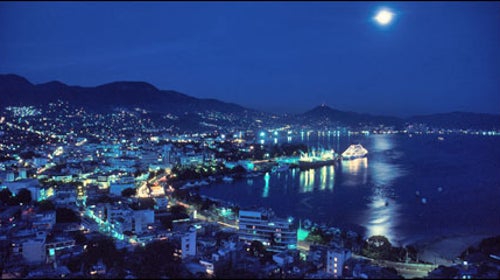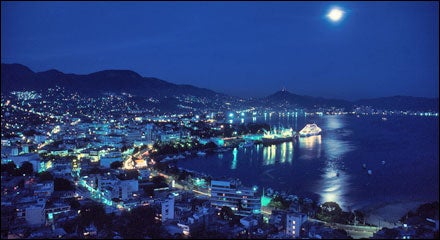FOR FOUR DAYS NOW, my buddy Tim and I have been ripping around central Mexico tasting tequilas. We’ve visited distilleries and factory stores in the 7,000-foot highlands east of Guadalajara. Here to the west, on La Ruta del Tequila, we’ve followed the government-designated “Tequila Trail,” which circles a low volcano while passing through municipalities where the liquor is made, including El Arenal, Amatit├ín, Tequila, and Magda┬şlena. On La Ruta, most of the other tourists are Mexican couples looking for old set locations of a popular telenovela called Destilando Amor (“Distilling Love”). We’re here to drink the world’s finest tequilas.
╠ř
Today is a lazy day-we’re tired and a little hungover-so when Tim and I swing into a cantina between Amatit├ín and Tequila in the afternoon, it’s just to see what’s up. The open-air highwayside bar is called Jarritos el Guero and serves a Mexican margarita made with fresh grapefruit, orange, lime, salt, and a splash of Squirt. As we make our way across the patio, a voice from behind calls out, “Hi!”
Five women in their early twenties, all wearing the canary-yellow polo shirts issued to employees at the Cuervo factory and museum down the road, beckon us over. The women explain in English that they recognized tall-hair, big-smile Tim from our tour yesterday.
“Why do you drive all the way out here to drink?” I ask. “Don’t you get free liquor from Cuervo?”
“Yes,” one of the women says, “but this tequila is the best!”
She offers her clay mug, and, sure enough, the tequila inside seems uncommonly smooth and strong. But it’s tough to say much more than that, since the flavor is buried by citrus. “What is it?” I ask.
She says it’s a high-proof bootleg called De la Sierra. Who makes it, and where, is a mystery. The women provide various contradictory answers-“It’s made by drug runners”; “It’s made in the hills over there”; “No! Over there”-but they take off before we can sort things out.
We haven’t really tasted this secret tequila. We don’t know where it’s distilled. But we’ve got to find it. Fate or felicity has brought us here. The Cuervo ladies have pointed to the horizon.
TEQUILA IS MADE from a single species of agave, Agave tequilana Weber, a spiky-leaf succulent related to the lily that takes between seven and ten years to mature and whose large heart, when cooked, tastes like tangy apricot.
Tequila’s country cousins-sotol, raicilla, bacanora, worm-drowning mezcal-are made in different areas from different species of agave. Real tequila comes only from Jalisco-a Mexican state about the size of South Carolina-and a couple of neighboring hamlets.
The best tequilas are the sipping tequilas made purely from agave, like Cuervo Tradicional. Mexicans call this cien por ciento (“one hundred percent”), as opposed to mixto or “tequila tequila” like Cuervo Gold, which is only 51 percent agave, the minimum allowed by law. The rest is stuff like sugar, caramel color, and other additives.
Cien por ciento comes in four grades based on age. Blanco is bottled almost straight from the distillation tank. Reposado (“rested”) sits at least two months in wooden barrels to soften the flavor. A├▒ejo, or “aged,” tequila rests for at least a year. Since 2006, there’s been a grade called extra a├▒ejo, aged three years or more. Blancos are often used for margaritas, and the others for sipping, but all can be excellent straight or mixed.
Legend has it that primitive tequila was discovered by an ancient tribesman who stumbled on an agave heart that was flash-fermented by a lightning strike. (Dude!) However it started, tequila-making isn’t very complex. Cook the agave to release its sugar, add yeast to turn the sugar to alcohol, separate the alcohol through distillation, and voil├á: basic tequila. Many locals still whip up home brew with this rudimentary technique.
Of course, the process has grown more sophisticated, thanks in large part to the 100-plus-year-old tequila superpowers: Cuervo, Sauza, and Herradura. Patr├│n, a top-ten manufacturer with a plant in Jalisco, was founded in 1989 by two Las Vegas-based Americans and is now the most popular sipping tequila in the world. The success of this young yanqui upstart has inspired resentment among its Mexican competitors, but there’s no denying that it has introduced millions to the joys of sipping. Patr├│n sold 100,000 cases in 2000; 1.6 million last year.
These days, rare is the big city without at least one high-class cantina boasting a mirrored wall of blown-glass bottles. A certified-organic tequila, 4 Copas, recently hit the market. And in 2006, a $225,000 bottle of tequila, called Pasi├│n Azteca, sold in Mexico City, setting the record for the most expensive bottle of liquor ever sold. This was a publicity stunt in which the makers dipped a bottle in “white-gold and platinum.” In the real world, serious tequila is an easier get, costing anywhere from $30 to $300.
WHICH IS NOT TO SAY that tequila has completely lost its reputation as firewater, the go-to slam juice for frat boys. But Tim and I are past all that (yeah, right), so we set up our trip more like a Napa Valley wine tour. With the help of guide and designated driver David Ruiz, a well-connected 58-year-old who retired from Silicon Valley to lead custom tequila tours, we carefully scheduled the first three and a half days and left the last two and a half free for “follow-up.” Tim, a 32-year-old wine importer from Colorado, would function as our professional taster-think of him as the Nose.
Leaving Guadalajara at 8:30 A.M. on opening day, we exited Highway 15 at Arenal, the start of La Ruta, crossed over a river green with sludge, and parked at our first small distillery, Fabrica de Tequila Cascahuin, which recently began producing a $700 limited-edition tequila called Revoluci├│n Oro. Inside, we saw that the fermented agave traveled to the distillation tanks through an open ditch in a concrete walkway, so we didn’t stay long enough to taste it. Mistake. By early afternoon, we realized that a lot of tequila, including some great stuff, is produced under conditions that look pretty disgusting. We decided to spend more time drinking and less time peering at factory floors.
We became wonks, noting “slow legs” and “long finishes,” “amber hues” and “hot burns.” Experts will tell you that the differences in sipping tequilas are not as dramatic as they are with single-malt Scotches, but we found more than enough subtleties to keep us fascinated-hints of brown sugar, honey, pepper, butter, cabbage, sweet potato, cooked banana, apricot, apple, lemon, pear, mint, strawberry, coconut, and apple blossom. Alas, Tim forbade me to use the word ambrosia.
On our second day we tasted 17 tequilas and found ourselves agreeing with the cognoscenti: The tequilas on La Ruta taste more herby, while those from the highlands are more floral. We also developed two theories of our own. First, that tequilas produced by the big tequila houses tend to be more approachable, because they taste pure, while the product from smaller manufacturers tends to have more character, more varied flavors. Second, that an aged tequila is the highest form of the art.
This came to us while tasting what proved to be our favorite, a stellar extra a├▒ejo called D’Anta├▒o de la Casa Siete Leguas. In many aged tequilas, the agave flavor is buried under sweet oak, or it appears out of nowhere, a come-hither look followed by a slap across the face. But this rare five-year crescendoed through toffee, caramel, pear, and banana to a twinkling high note of slightly peppery agave, then faded back to sweet and slowly away.
And did I really just say that? Hmmm. I think it’s time to put down my stemware and holster the similes.
ON DAY THREE we struck out on our own, rounding the volcano through fields of sugarcane, arriving late in the day at Teuchitlán, the last stop on La Ruta. It turned out not to have a single distillery.
We checked in to what a woman at a corner shop told us was the only lodging in town, a single-story fleabag called, simply, Hotel. ║┌┴¤│ď╣¤═°, by a row of parked cars beside the plaza, a dozen local dudes were bartending “tequila tequila” drinks off the hood of a white sidestep pickup. They ranged from fat to muscular, with bald heads and soul patches. “Amigos,” they hollered, “you want some tequila?”
Tim and I approached with a certain amount of gringo timidity, but it turned out the guys were dentists, lawyers, and scientists. They handed us plastic cups half filled with Squirt and El Jimador, Mexico’s best-selling tequila. We knocked back big slugs of the mixed drink, called a paloma (“dove”), and the night started taking on a logic of its own.
I was dubbed Shaggy, from Scooby-Doo, the hipness of my tousled hair apparently lost on them. Sip, gulp.
A four-wheeler sputtered down the quiet street, piled high with a dozen or so kids, all waving at us. Gulp.
“Ranas del diablo!” yelled one of our cabr├│ns. It was nine-ish, we were starved, and they insisted we try spicy frogs. The woman at the grill nearby took pity on us and offered us hamburgers. Gulp.
At 10:30 P.M., the tequila bottles were drained and the party was about to dissolve. Then, up rode a cowboy: spurs, serape, the whole bit. He swung a leg off his horse, reached under the saddle to produce two bottles of lesser “tequila tequila,” and handed the reins to Tim without a word, as if Tim were some kind of equine parking valet. The bar was open again! Gulp.
“Go for a ride, Shaggy,” someone yelled. Caballeros Shaggy and Tim took turns riding around the plaza, after which we all roamed the town, crashing wedding parties.
Around 1 A.M., Tim and I staggered back to the hotel. It was an unforgettable night that I mostly remember.
THE NEXT MORNING, noticing that my sheets were covered with other people’s love stains, I ran shrieking from my bed as if it were on fire. Feeling hungover but fulfilled, we headed back to Tequila to track down distillers we’d missed earlier. No luck. And that’s when we ran into the Cuervo women. Curiosity trumped connoisseurship once again.
This afternoon, we’re on the hunt for De la Sierra, climbing a rough dirt road up the 2,000-foot wall of a red mesa, following a map drawn by Jesus, the proprietor of Jarritos el Guero. “When you get to El Salvador, ask for it,” he said.
After two hours, the road dumps us in El Salvador, a nearly deserted hamlet of wind-battered mud-brick houses. No one has heard of De la Sierra-not the two men on the plaza, not the men in the grimy cantina, and not the lonely woman selling candy, who simply looks away, like we’ve come to kidnap her son. We wander the streets looking for someone-anyone-and feeling stumped.
“Do you know De la Sierra?” we ask a man resembling Burt Reynolds with a belly.
When he says no, we snap and tell him our frustrating story-how we happened to meet these Cuervo ladies, how we limped up here in a wimpy car, etc. At the end of our lament, he looks at us, smiles, and leads us through a courtyard to the back of a garage, where three dusty barrels sit in a dark corner. “I make De la Sierra,” he announces, introducing himself as Miguel.
Miguel is a zucchini farmer. Even with his farm obligations, he still turns out about 20,000 liters of 110-proof De la Sierra annually. He sells the blanco to Jesus and keeps this extra a├▒ejo for himself, his family, and his friends. It costs a buck per liter to make and, yes, he says matter-of-factly, it’s illegal. “Do you want to see the distillery?” he asks. Heck, yeah!
We pack into the cab of a Toyota pickup, leave town on a side street, and bounce across open ranchland. I have no idea where we are. After a half-hour, Miguel hops out to undo a section of barbed-wire fence. We drop down into a valley of white oak. And there it is beside a stream: Miguel’s hooch factory.
“This is how you make good tequila,” he says, pointing to a tar-paper roof propped over vats of agave mulch and a steaming, sweating brick outbuilding. An old man in a camo jacket looks on silently while we inspect the propane-powered blast furnace with the jury-rigged exhaust pipe. We sample the water coming from a hose stuck in a nearby spring. We ogle the monstrous agaves growing wild. We pull open the small iron door of the soot-black oven and climb inside.
When we step out, Miguel offers us samples, two plastic Mega Big Cola bottles, three liters each.
Tasted in the hotel that night, De la Sierra will display the delicate bouquet of wet fur, the lively flavor of raw hot dogs, and the subtle burn of chiles marinated in chlorine. Tim will give his to the clerk at the rental-car agency. I will bring some home, where it will remain untouched, eating away at the plastic of my Nalgene.
But at that moment-lost in a gorgeous canyon, tasting one man’s prized contraband-Tim and I are convinced that Miguel’s Mexican moonshine is the best tequila ever, 100 percent crazy good.


